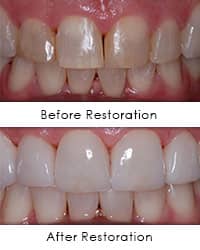Hairline Cracked Front Tooth

Hairline Cracks In Front Teeth. If a person grinds their teeth or clenches their jaw in their sleep, they may wish to talk to their dentist about wearing a mouthguard at night. Related coverage Hairline Crack Down Front Tooth. Infectious Diseases / Bacteria / Viruses Primary Care / General Practice Public Health. Extreme temperature changes: When tooth enamel is rapidly exposed to opposite temperature extremes – for example, immediately biting into an ice cube after burning your mouth on a piping-hot cup of tea – it can lead to hairline cracks. This is because enamel expands and contracts during temperature changes. Salt Rinse The absolute first step in dealing with a cracked tooth before any tooth repair is to fill a glass with warm but not boiling water and adding a tablespoon of salt to it. Once the salt has completely dissolved, rinse the mouth several times. If you are able to, gargling with it would also be a good idea.
How To Fix Hairline Cracks In Front Teeth
Cracked teeth are quite common. Images of these on a monitor can be quite impressive. Dentists and hygienists may encourage patients to pursue a crown as a result of the presence of a crack in a tooth. The purpose of this post is to inform patients of when cracks require dental treatment. Evidence based dentistry dictates that NOT all cracked teeth require crowns.
To be honest with you, if we magnify an image of most any tooth in your mouth, we most likely will visualize cracks. Teeth crack over time due to usage, biting forces, and possibly grinding. It is easy to find these cracks and to demonstrate them on an image. There are characteristics of these cracks which can indicate when a crown is necessary to strengthen and protect a tooth.
One of the characteristics which demonstrates the need for a crown is when the crack has darkness which has seeped into the crack and into the adjacent tooth structure. This is an indication of decay. Under bright illumination like a constantly lit camera flash, healthy tooth structure reflects light back to the camera. As a result, healthy tooth structure appears very bright and white. On the other hand, decayed tooth structure absorbs the light. As a result, decayed tooth structure appears darker, like gray clouds which are associated with rain, or even darker. Teeth like these most likely will require protection with a partial crown or a full crown.
Another characteristic which demonstrates the need for a crown is the presence of a severely painful tooth immediately upon biting or letting go of the bite. Following this instant stimulus the pain goes away immediately. This is an indication of a cracked tooth into the deeper second layer of the tooth, the dentin. You see, the biting forces cause the tooth segments to spread apart and sensitize the deeper tooth structure containing the nerve fibers. Most of the time, the crown will hold the tooth segments together to prevent that same sharp painful stimulus. Other times the pain occurs less often and less intensely with the protection under a crown. However, there are times when even the crown may not protect the tooth from the sensitivity of biting. In these cases the tooth may well be recommended for root canal treatment.
So then, it follows that if there is no pain to biting and no presence of decay, then the tooth may NOT be recommended for a crown. Even though a magnified image may illustrate the clear presence of a crack, there still might not be enough evidence to rationalize placing a crown on the tooth.
We invite you to peruse our website for more information. We invite you to contact us at (972) 250-2580 to ask questions or to make an appointment for you or a family member, friend, or coworker. We would value your trust. Thank you for your interest in our web page.